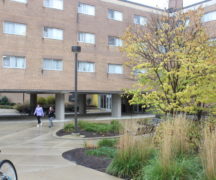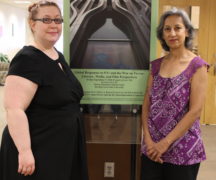By FRANCES BRENT
Kathrine Boo, possessor of a Pulitzer Prize for Investigative Reporting, a MacArthur Genius Fellow for just being, a National Book Award for non-fictional writing, The Hillman for social justice writing , etc. is small. She is fair to the point of near transparency yet has “the arm of an investigative reporter and the soul of a poet.” She endured four years of India’s Southern sun and then wrote her book.
Her book, the best selling “Behind the Beautiful Forevers: Life, Death and Hope in a Mumbai Undercity was the BGSU Common Read selection for 2015. Tuesday night she spoke at the Union to a rapt audience of students and visitors. The book has no “I” but chronicles her observations, insights, and entwinement with the people of the “stumpy plug of slum” Annawandi — tucked next to 5 star hotels and the glamorous, booming Mumbai Airport. It is investigative reporting, done over four years, that reads like a novel – filled with striving humans, a relentless environment, corrupt officials, murder, terrible suspense and an uncertain ending.
Katherine Boo, writing for the New Yorker has become the historian of modern poverty, injustice, deprivation, hopelessness, isolation. She records disasters bestowed on humans by the implacable hands of nature, government, greed, history, religion and fellow human beings. “Behind the Beautiful Forevers” recounts tales of human resiliency, ingenuity, tactics, hopes, treachery, envy, bravery and determination. She deals with success and failure, hope and despair.
If her revelations has an effect on public policy so be it. She is the bearer of news, not the shaper of public policy. Asked by a tender-hearted student why Boo didn’t rescue individuals she came to know well, she spoke of journalistic ethics involving money. While writing about individuals, her work and impact is long term. The book “no one would want to read” has proven popular and provides the means to help indirectly.
Her calm, implacable, clear sighted recounting of what she had learned over four years of involvement is more effective than any polemic in arousing strong emotions. Boo used multi-media to document her observations. She speaks truth with documents in hand.
After reading about the mud, the squalor, the crowding, the unreliable water supply the cleanliness and comeliness of her subjects was startling. Another manifestation of human resilience, a recurring theme.
“Behind the Beautiful Forevers” is not an easy book because the reality is not easy. They is much sorrow packed in those 287 pages. Hope, however, predominates. India continues to have a volatile economy, a government that combines lofty idealism with endemic corruption and racial tensions. Told with unsentimental rigor and grace Katherine Boo writes gripping story.





